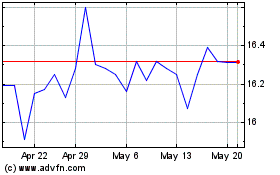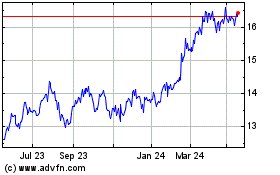2nd UPDATE: National Australia Bank, Westpac Raise Mortgage Rates
November 12 2010 - 2:02AM
Dow Jones News
National Australia Bank Ltd. (NAB) and Westpac Banking Corp.
(WBK) on Friday became the last two of Australia's big four banks
to hit homeowners by raising rates on mortgages beyond the
country's central bank, adding to stress on consumers already
struggling with surging inflation and a recent rise in the
country's unemployment rate.
Australia's second and fourth largest lenders to home buyers
join Commonwealth Bank of Australia (CBA.AU) and Australia &
New Zealand Banking Group Ltd. (ANZ) by hiking their standard
variable home loan interest rates. Westpac increased its rate by 35
basis points to 7.86%, while NAB raised its lending rates by 43
basis points to 7.67%. Commonwealth's rate is 7.81% and ANZ's rate
is 7.80%.
Westpac, which last week announced an 84% rise in net profit, is
the country's second largest home lender with a mortgage book of
about A$250 billion (US$249.82 billion). The moves by the country's
four big banks follow the Reserve Bank of Australia's decision last
week to raise its cash rate by 25 basis points to 4.75% and
threatens to have a broad economic impact given consumer spending
makes up roughly two-thirds of Australia's economy.
"This is around A$1000 (a year) on a A$300,000 home loan and
it's exactly what Australian homeowners didn't want in the run up
to Christmas. It's exactly what Australian small businesses didn't
want in the lead up to the festive season," said Shadow Treasurer
Joe Hockey, a vocal critic of the country's big four banks.
Coupled together, the increases add even more pressure on the
government to rein in banks on concerns that Australia's economy is
overheating on China's insatiable demand for the country's iron ore
and coal, pushing the cost of living higher. In the past week,
government officials have increasingly called into question the
tactics of the country's big banks, with Treasurer Wayne Swan
promising a banking reform package aimed at taking more mortgages
off of the big four's books and even threatening punitive
measures.
"The government will unveil further reforms...to ensure
competition in this market," Australia's Finance Minister Penny
Wong said at a doorstop in Sydney. "There isn't any justification
for any major bank putting in place an interest rate rise above the
official interest rate."
Banks have countered by saying the higher lending rates were
needed because the average cost the banks pay to fund its lending
to customers, both from overseas and through deposits, has been
rising and is expected to continue to rise for the foreseeable
future.
ANZ's rate increase adds about A$90 a month to payments on the
average A$300,000 mortgage, according to a Dow Jones Newswires
calculation, with Westpac's moving adding about A$80. Combined, the
country's big four banks hold roughly 90% of the country's
mortgages on their books, compared with nearly 60% four years ago
as a collapse in securitization markets have left smaller lenders
weak.
Smaller lenders use securitization markets as their primary
source of funding.
In addition to raising rates, NAB joined ANZ by saying it will
abolish early exit fees on new and existing home loans, something
the government has already promised would be a part of its
reforms.
But Australian real estate experts say the lowered exit fees do
little to temper the affect of rising rates, with cost of living
concerns further compounded by data on Thursday showing the
country's unemployment rate rose to 5.4% from 5.1% last month.
About 90% of Australian home owners have variable loans.
Sam White, deputy chairman of Australia's largest mortgage
broker, Ray White, said it's not just the country's ongoing
property price boom that will be hit by the interest rate raises,
but also the cost of living.
"Most people were surprised when the RBA moved and then the
compounding affect of the banks has been more than just a
double-whammy for Australian families," said White.
White noted homeowners are already changing mortgage originators
in the wake of Commonwealth Bank's move. His firm arranges about
A$600 million worth of home loans a month with smaller firms such
as Suncorp-Metway Ltd. (SUN.AU) and Bendigo and Adelaide Bank Ltd.
(BEN.AU) now seeing an uptick in business. After large banks
regularly had about a 90% share of the loans Ray White originated
since the global financial crisis, that figure has recently dipped
to about 60%.
In addition to helping smaller lenders through securitization
markets, the government has also said it hopes foreign banks,
including Citigroup Inc. (C) and ING Groep NV (ING), will step up
efforts in Australia's mortgage market.
"Foreign investment is welcome and if there were further
participants who wanted to work in the Australian market, we would
welcome that," said Treasurer Swan from the G-20 meeting in
Seoul.
-By Geoffrey Rogow, Dow Jones Newswires; +61-2-8272-4686;
geoffrey.rogow@dowjones.com
(David Fickling contributed to this report)
Suncorp (ASX:SUN)
Historical Stock Chart
From Mar 2024 to Apr 2024

Suncorp (ASX:SUN)
Historical Stock Chart
From Apr 2023 to Apr 2024
